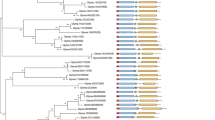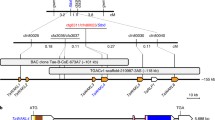Abstract
Verticillium dahliae, the causative agent of Verticillium wilt, results in significant cotton (Gossypium hirsutum) crop losses worldwide. Identification of host genes involved in mounting an effective defence response may suggest targets for alternative control methods for this devastating fungus. In this study, the identification, cloning and characterisation of a V. dahliae elicitor-responsive lectin receptor-like kinase (GhLecRK-2) is described. Bioinformatic analysis of its deduced amino acid sequences revealed that GhLecRK-2 consists of an external legume-like lectin (L-lectin) domain, a single transmembrane spanning domain and a C-terminal Ser/Thr-specific protein kinase domain. In silico analysis of the promoter sequence revealed that it contains several defence-responsive regulatory elements. Expression analysis revealed that transcription of GhLecRK-2 is significantly up-regulated in response to treatment with a cell wall-derived V. dahliae fraction. The nature of the L-lectin domain suggests that GhLecRK-2 may be capable of interacting with the glycoconjugate-based fraction, and the enhanced transcription of GhLecRK-2 upon treatment with the cell wall extract suggests a role in perception and the activation of defence responses.






Similar content being viewed by others
References
André S, Siebert HC, Nishiguchi M, Tazaki K, Gabius HJ (2005) Evidence for lectin activity of a plant receptor-like protein kinase by application of neoglycoproteins and bioinformatic algorithms. Biochim Biophys Acta 1725:222–232
Baillieul F, Genetet I, Kopp M, Saindrenan P, Fritig B, Kauffmann S (1995) A new elicitor of the hypersensitive response in tobacco: a fungal glycoprotein elicits cell death, expression of defence genes, production of salicylic acid, and induction of systemic acquired resistance. Plant J 8:551–560
Barre A, Hervé C, Lescure B, Rougé P (2002) Lectin receptor kinases in plants. CRC CR Rev Plant Sci 21:379–399
Boller T, Felix G (2009) A renaissance of elicitors: perception of microbe-associated molecular patterns and danger signals by pattern-recognition receptors. Annu Rev Plant Biol 60:379–406
Bouwmeester K, Govers F (2009) Arabidopsis L-type lectin receptor kinases: phylogeny, classification, and expression profiles. J Exp Bot 60:4383–4396
Bouwmeester K, Klamer S, Gouget A, Hagnet N, Canut H, Govers F (2008) Lectin receptor kinase 79, a putative target of the Phytophthora infestans effector IPI-O. In: Lorito M, Woo SL, Scala F (eds) Biology of plant–microbe interactions. International Society for Molecular Plant–Microbe Interactions, St Paul
Bouwmeester K, de Sain M, Weide R, Gouget A, Klamer S, Canut H, Govers F (2011) The lectin receptor kinase LecRK-I.9 is a novel Phytophthora resistance component and a potential host target for a RXLR effector. PLoS Pathog 7:e1001327. doi:10.1371/journal.ppat.1001327
Chen X, Shang J, Chen D, Lei C, Zou Y, Zhai W, Liu G, Xu J, Ling Z, Cao G, Ma B, Wang Y, Zhao X, Li S, Zhu L (2006) A B-lectin receptor kinase gene conferring rice blast resistance. Plant J 46:794–804
Dardick C, Ronald P (2006) Plant and animal pathogen recognition receptors signal through non-RD kinases. PLoS Path 2:0014–0028
Domenech J, Prieto A, Gómez-Miranda B, Leal JA, Ahrazem O, Jiménez-Barbero J, Bernabé M (2002) Structure of fungal polysaccharides isolated from the cell-wall of three strains of Verticillium fungicola. Carbohyd Polym 50:209–212
Dubery IA, Slater V (1997) Induced defence responses in cotton leaf discs by elicitors from Verticillium dahliae. Phytochemistry 44:1429–1434
Dubery IA, Sanabria NM, Huang J-C (2012) Non-self perception in plant innate immunity. Adv Exp Med Biol 783:79–107
Eulgem T (2005) Regulation of the Arabidopsis defence transcriptome. Trends Plant Sci 10:71–78
Eulgem T, Somssich IE (2007) Networks of WRKY transcription factors in defence signaling. Curr Opin Plant Biol 10:366–371
Gouget A, Senchou V, Govers F, Sanson A, Barre A, Rougé P, Pont-Lezica R, Canut H (2006) Lectin receptor kinases participate in protein-protein interactions to mediate plasma membrane-cell wall adhesions in Arabidopsis. Plant Physiol 140:81–90
Gust AA, Brunner F, Nürnberger T (2010) Biotechnological concepts for improving plant innate immunity. Curr Opin Biotechnol 21:1–7
Hanks SK (2003) Genomic analysis of the eukaryotic protein kinase superfamily: a perspective. Genome Biol 4:1–7
Hanks SK, Quinn AM (1991) Protein kinase catalytic domain sequence database: identification of conserved features of primary structure and classification of family members. Methods Enzymol 200:38–62
Häweker H, Rips S, Koiwa H, Salomon S, Saijo Y, Chinchilla D, Robatzek S, von Schaewen A (2010) Pattern recognition receptors require N-glycosylation to mediate plant immunity. J Biol Chem 285:4629–4636
Hervé C, Dabos P, Galaud JP, Rougé P, Lescure B (1996) Characterization of an Arabidopsis thaliana gene that defines a new class of putative plant receptor kinases with an extracellular lectin-like domain. J Mol Biol 258:778–788
Hervé C, Serres J, Dabos P, Canut H, Barre A, Rougé P, Lescure B (1999) Characterization of the Arabidopsis lecRK-a genes: members of a superfamily encoding putative receptors with an extracellular domain homologous to legume lectins. Plant Mol Biol 39:671–682
Jalali BL, Bhargava S, Kamble A (2006) Signal transduction and transcriptional regulation of plant defence responses. J Phytopathol 154:65–74
Joshi A, Dang HQ, Vaid N, Tuteja N (2010) Pea lectin receptor-like kinase promotes high salinity stress tolerance in bacteria and expresses in response to stress in planta. Glycoconj J 27:133–150
Kanzaki H, Saitoh H, Takahashi Y, Berberich T, Ito A, Kamoun S, Terauchi R (2008) NbLRK1, a lectin-like receptor kinase protein of Nicotiana benthamiana, interacts with Phytophthora infestans INF1 elicitin and mediates INF1-induced cell death. Planta 228:977–987
Kelley LA, Sternberg MJ (2009) Protein structure prediction on the Web: a case study using the Phyre server. Nat Protoc 4:363–371
Larionov A, Krause A, Miller W (2005) A standard curve based method for relative real time PCR data processing. BMC Bioinformatics 6:62
Lazarovits G, Subbarao K (2009) Challenges in controlling Verticillium wilt by the use of nonchemical methods. In: Gisi U, Chet I, Gullino M (eds) Recent developments in management of plant diseases. Springer, Netherlands, pp 247–264
Murray MG, Thompson WF (1980) Rapid isolation of high molecular weight plant DNA. Nucleic Acids Res 8:4321–4325
Navarro L, Zipfel C, Rowland O, Keller I, Robatzek S, Boller T, Jones JD (2004) The transcriptional innate immune response to flg22 interplay and overlap with Avr gene-dependent defence responses and bacterial pathogenesis. Plant Physiol 135:1113–1128
Navarro-Gochicoa MT, Camut S, Timmers AC, Niebel A, Hervé C, Boutet E, Bono JJ, Imberty A, Cullimore JV (2003) Characterization of four lectin-like receptor kinases expressed in roots of Medicago truncatula. Structure, location, regulation of expression, and potential role in the symbiosis with Sinorhizobium meliloti. Plant Physiol 133:1893–1910
Ndimba BK, Chivasa S, Hamilton JM, Simon WJ, Slabas AR (2003) Proteomic analysis of changes in the extracellular matrix of Arabidopsis cell suspension cultures induced by fungal elicitors. Proteomics 3:1047–1059
Nishiguchi M, Yoshida K, Sumizono T, Tazaki K (2002) A receptor-like protein kinase with a lectin-like domain from lombardy poplar: gene expression in response to wounding and characterization of phosphorylation activity. Mol Genet Genomics 267:506–514
Ohtake Y, Takahashi T, Komeda Y (2000) Salicylic acid induces the expression of a number of receptor-like kinase genes in Arabidopsis thaliana. Plant Cell Physiol 4:1038–1044
Pantelides IS, Tjamos SE, Paplomatas EJ (2010) Ethylene perception via ETR1 is required in Arabidopsis infection by Verticillium dahliae. Mol Plant Pathol 11:191–202
Riou C, Herve C, Pacquit V, Dabos P, Lescure B (2002) Expression of an Arabidopsis lectin kinase receptor gene, lecRK-al, is induced during senescence, wounding and in response to oligogalacturonic acids. Plant Physiol Biochem 40:431–438
Sambrook J, Fritsch EF, Maniatis T (1989) Molecular cloning: a laboratory manual. Cold Spring Harbour Laboratory Press, Cold Spring Harbour
Sanabria N, Goring D, Nürnberger T, Dubery IA (2008) Self/non-self perception and recognition mechanisms in plants; a comparison of self-incompatibility and innate immunity. New Phytol 178:503–514
Sanabria N, van Heerden H, Dubery IA (2012) Molecular characterization and regulation of a Nicotiana tabacum S-domain receptor-like kinase gene induced during an early rapid response to lipopolysaccharides. Gene 501(1):39–48. doi:10.1016/j.gene.2012.03.073
Sasabe M, Naito K, Suenaga H, Ikeda T, Toyoda K, Inagaki Y, Shiraishi T, Ichinose Y (2007) Elicitin-responsive lectin-like receptor kinase genes in BY-2 cells. DNA Seq 18:152–159
Sharon N (1993) Lectin-carbohydrate complexes of plants and animals: an atomic view. Trends Biochem Sci 18:221–226
Shibuya N, Minami E (2001) Oligosaccharide signalling for defence responses in plant. Physiol Mol Plant Pathol 59:223–233
Shiu SH, Bleeker AB (2001) Plant receptor-like kinase gene family: diversity, function, and signalling. Science 113:re22
Silipo A, Erbs G, Shinya T, Dow JM, Parrilli M, Lanzetta R, Newman MA, Molinaro A (2010) Glyco-congugates as elicitors or suppressors of plant innate immunity. Glycobiology 20:406–419
Singh K, Foley RC, Oñate-Sánchez L (2002) Transcription factors in plant defence and stress responses. Curr Opin Plant Biol 5:430–436
Tamura K, Peterson N, Stecher G, Nei M, Kumar S (2011) MEGA5: molecular evolutionary genetics analysis using maximum likelihood, evolutionary distance, and maximum parsimony methods. Mol Biol Evol 28:2731–2739
Ton J, Flors V, Mauch-Mani B (2009) The multifaceted role of ABA in disease resistance. Trends Plant Sci 14:310–317
Wan J, Zhang XC, Neece D, Ramonell KM, Clough S, Kim S, Stacey MG, Stacey G (2008a) A LysM receptor-like kinase plays a critical role in chitin signaling and fungal resistance in Arabidopsis. Plant Cell 20:471–481
Wan J, Patel A, Mathieu M, Kim SY, Xu D, Stacey G (2008b) A lectin receptor-like kinase is required for pollen development in Arabidopsis. Plant Mol Biol 67:469–482
Willmann R, Lajunen HM, Erbs G, Newman MA, Kolb D, Tsuda K, Katagiri F, Fliegmann J, Bono JJ, Cullimore JV, Jehle AK, Götz F, Kulik A, Molinaro A, Lipka V, Gust AA, Nürnberger T (2011) Arabidopsis lysin-motif proteins LYM1 LYM3 CERK1 mediate bacterial peptidoglycan sensing and immunity to bacterial infection. Proc Natl Acad Sci USA 108:19824–19829
Wong M, Medrano J (2005) Real-time PCR for mRNA quantification. Biotechnology 39:75–85
Xin Z, Wang A, Yang G, Gao P, Zheng ZL (2009) The Arabidopsis A4 subfamily of lectin receptor kinases negatively regulates abscisic acid response in seed germination. Plant Physiol 149:434–444
Xing W, Zou Y, Liu Q, Liu J, Luo X, Huang Q, Chen S, Zhu L, Bi R, Hao Q, Wu JW, Zhou JM, Chai J (2007) The structural basis for activation of plant immunity by bacterial effector protein avrpto. Nature 449:243–247
Zhang SH, Du H, Klessig DF (1998) Activation of the tobacco SIP kinase by both a cell wall-derived carbohydrate elicitor and purified proteinaceous elicitins from Phytophthora spp. Plant Cell 10:435–449
Zipfel C, Kunze G, Chinchilla D, Caniard A, Jones JD, Boller T, Felix G (2006) Perception of the bacterial PAMP EF-Tu by the receptor EFR restricts Agrobacterium-mediated transformation. Cell 125:749–760
Zuo K, Zhao J, Wang J, Sun X, Tang K (2004) Molecular cloning and characterization of GhlecRK, a novel kinase gene with lectin-like domain from Gossypium hirsutum. DNA Seq 15:58–65
Zwiegelaar (2003) DDRT-PCR analysis of defence-related gene induction in cotton. M.Sc. thesis, RAU University, Johannesburg, SA
Zwiegelaar M, Dubery IA (2005) Early activation of cell wall strengthening-related gene transcription in cotton by a Verticillium dahliae elicitor. S Afr J Bot 72:467–472
Acknowledgments
This work was supported by the South African National Research Foundation and the University of Johannesburg, South Africa.
Author information
Authors and Affiliations
Corresponding author
Rights and permissions
About this article
Cite this article
Phillips, S.M., Dubery, I.A. & van Heerden, H. Identification and Molecular Characterisation of a Lectin Receptor-like Kinase (GhLecRK-2) from Cotton. Plant Mol Biol Rep 31, 9–20 (2013). https://doi.org/10.1007/s11105-012-0470-2
Published:
Issue Date:
DOI: https://doi.org/10.1007/s11105-012-0470-2




